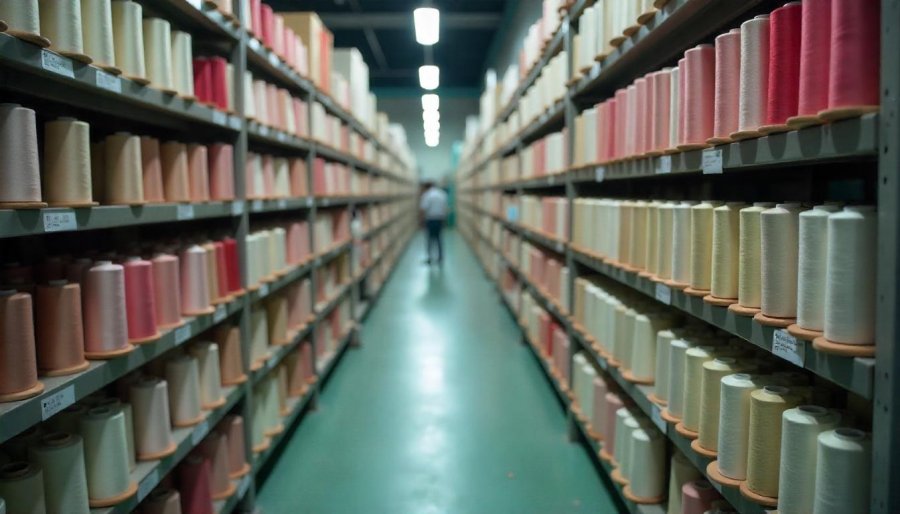
Nylon, a staple of modern life, offers durability and versatility but at an often unseen environmental cost. Its production relies heavily on fossil fuels, involving energy-intensive processes that emit greenhouse gases, disrupt ecosystems, and deplete finite resources. Once manufactured, nylon persists for centuries, fragmenting into microplastics that infiltrate oceans, lakes, and soils—threatening wildlife and entering the food chain, including human consumption. Despite technological advances, pollution from manufacturing and waste continues to worsen climate change and ecological degradation. The contrast between nylon’s convenience and its long-term environmental damage raises urgent questions: can we innovate sustainable alternatives or improve recycling efforts fast enough to mitigate this legacy? As demand grows, understanding nylon’s complex impact becomes vital—are we willing to reconsider our reliance on petrochemical-derived materials to safeguard the planet’s future?

Unveiling Nylon’s Hidden Environmental Footprint
Nylon is one of those materials that’s woven into many aspects of our daily lives, often without us giving it much thought. From the stretchy tights we wear to the carpets under our feet, nylon’s presence is everywhere. Its popularity stems from being lightweight, strong, and surprisingly versatile, making it a go-to choice for everything from clothing and accessories to industrial applications like fishing lines and car parts. This widespread use has transformed industries, offering products that are durable, affordable, and easy to produce. Yet, behind this convenience lies a complex web of environmental impacts that many of us remain unaware of.
At its core, nylon is a synthetic fiber classified as a polyamide, created from long chains of molecules containing amide groups. It’s produced through a process called condensation polymerization, where simpler chemicals are combined to form these resilient fibers. The most common types—nylon 6 and nylon 6,6—share many properties: they are lightweight, resistant to wear, and chemically stable. These qualities explain why nylon is so embedded in our everyday products; it’s durable enough to last for years, and its low cost makes it accessible to nearly everyone. However, this very durability is also what makes nylon an environmental challenge, as it doesn’t break down easily once discarded.
The journey of nylon begins with fossil fuels—mainly oil and natural gas—which serve as the raw materials for its chemical building blocks. These fuels undergo intensive refining to produce hydrocarbons like ethylene, benzene, and other aromatic compounds. These chemicals are then processed into monomers such as hexamethylenediamine and adipic acid, which are combined through chemical reactions to create nylon’s long polymer chains. The entire process is energy-intensive, relying heavily on burning fossil fuels, which releases significant amounts of greenhouse gases and other pollutants into the environment. Additionally, the extraction and refining of these fuels often cause habitat destruction, water contamination, and air pollution, adding further strain to ecosystems before nylon even reaches manufacturing.
Once these chemicals are synthesized, they undergo polymerization—a process that links the monomers into long, stable chains. This step requires precise control of temperature and pressure, demanding substantial energy input. During this phase, byproducts and residual chemicals are generated, which, if not properly managed, can escape into surrounding environments, contributing to air and water pollution. The reliance on non-renewable resources makes nylon’s production inherently unsustainable, as it accelerates resource depletion and environmental degradation. The infrastructure supporting fossil fuel extraction and chemical manufacturing leaves a lasting ecological footprint, from drilling rigs to refineries, further exacerbating the environmental cost.
From production to disposal, nylon’s environmental impact persists. Its chemical resilience means it can take hundreds of years to decompose in landfills, gradually fragmenting into microplastics—tiny fibers shed during washing or as the material degrades naturally. These microplastics contaminate oceans, lakes, and soils, posing a threat to wildlife and entering the food chain. Marine animals often ingest these fibers, mistaking them for food, which can lead to injury or death. As these tiny particles spread, they threaten both ecosystems and human health, especially as they accumulate in seafood and drinking water. This durability, which makes nylon so useful, also ensures it remains a long-term burden on our planet, turning into a persistent source of pollution that is difficult to manage.
In short, nylon’s role in our daily lives is undeniable, but its environmental footprint is equally significant. From the fossil fuels that power its production to the microplastics that now pervade our environment, the impacts are far-reaching and long-lasting. Recognizing these issues is crucial as we consider more sustainable alternatives and smarter waste management strategies. The challenge lies in balancing the benefits of nylon’s versatility with the urgent need to reduce its ecological harm, inspiring a shift toward greener materials and practices that can help us mitigate its long-term effects.

The Petrochemical Roots of Nylon: An Environmental Perspective
Nylon production begins with the extraction and processing of fossil fuels—primarily oil and natural gas—which serve as the raw materials for its chemical building blocks. These fuels undergo extensive refining to produce hydrocarbons such as ethylene, benzene, and other aromatic compounds. This refining process is energy-intensive, relying heavily on the combustion of fossil fuels, which releases substantial greenhouse gases and pollutants into the atmosphere. The chemicals derived from this stage form the foundation for synthesizing nylon’s key monomers, including hexamethylenediamine and adipic acid.
Transforming these hydrocarbons into usable monomers involves a series of complex chemical reactions. Cracking processes break down large hydrocarbon molecules into smaller, more reactive compounds like ethylene and benzene. These are then subjected to oxidation, amination, and other chemical transformations to produce the specific monomers used in nylon manufacturing. The production of hexamethylenediamine, for instance, requires precise control over reaction conditions, often involving hazardous solvents and catalysts. These steps not only demand significant energy input but also pose risks of chemical spills and environmental contamination if not managed carefully.
Once the monomers are synthesized, they are linked through condensation polymerization—a process that joins molecules like hexamethylenediamine and adipic acid into long, stable chains forming nylon polymers. This stage requires high temperatures and pressures, consuming large amounts of energy. During polymerization, byproducts and residual chemicals are generated, which, if improperly handled, can escape into nearby air and water sources. Such releases contribute to pollution and environmental degradation, further emphasizing the ecological footprint of nylon production.
The reliance on non-renewable fossil fuels makes nylon manufacturing inherently unsustainable. Extracting these fuels involves drilling and mining, which fragment ecosystems, threaten biodiversity, and risk spills or leaks that contaminate soil, water, and air. The infrastructure supporting these activities—pipelines, rigs, refineries—leaves a lasting ecological mark, often with far-reaching impacts. As demand for nylon grows globally, so does the pressure on these finite resources, creating a cycle of resource depletion and environmental harm that is difficult to break.
Chemical synthesis in nylon production is a significant contributor to climate change. The process emits vast quantities of greenhouse gases, including carbon dioxide, as well as volatile organic compounds and other pollutants. These emissions are not confined to factory sites but disperse into the atmosphere, adding to global warming and air quality issues. In regions with lax environmental regulations, pollution from chemical runoff and air emissions contributes to local health problems, making nylon’s production an environmental concern on multiple levels.
The environmental toll extends beyond production to the lifecycle of nylon products. Its chemical stability means it can take hundreds of years to decompose in landfills. During this time, nylon fragments into microplastics—tiny fibers shed during washing or natural degradation—which then infiltrate oceans, lakes, and soils. Marine life often ingests these microplastics, mistaking them for food, leading to injury or death. As these particles accumulate up the food chain, they pose risks to human health through contaminated seafood and drinking water.
Addressing the environmental impact of nylon requires a shift toward more sustainable practices. Innovations such as bio-based nylons derived from renewable resources could lessen reliance on fossil fuels and reduce ecological damage. Improving waste management and recycling infrastructure also plays a vital role in mitigating pollution. Ultimately, recognizing the petrochemical roots of nylon underscores the need for systemic change—balancing the material’s benefits with its ecological costs and exploring alternatives that align with a more sustainable future.

Nylon’s Environmental Toll Today: Pollution, Microplastics, and Sustainability Challenges
Today, the environmental impact of nylon is more visible than ever, revealing a troubling legacy that extends far beyond its initial convenience. Microplastics—tiny fibers shed during washing or as nylon degrades naturally—are now found in oceans, lakes, and even remote terrestrial environments. Marine animals often ingest these particles, mistaking them for food, which can lead to injury, starvation, or death. As they move up the food chain, these microplastics contaminate seafood and drinking water, posing direct risks to human health. The persistent presence of these fibers highlights how a durable material, designed for longevity, becomes a long-lasting pollutant that infiltrates ecosystems worldwide.
Nylon waste in landfills compounds this crisis. Its chemical resilience means it can take hundreds of years to break down naturally, instead fragmenting into microplastics that disperse into soil and water. These tiny particles don’t simply vanish; they leach toxic chemicals into the environment, affecting plants, animals, and humans alike. Landfills overflow with nylon debris, and because it doesn’t degrade easily, new waste continues to add to the global plastic pollution problem. Its durability, once a benefit, now ensures nylon remains a stubborn contaminant, polluting ecosystems for generations and complicating waste management efforts.
Manufacturing emissions and runoff further shape the current environmental landscape. Despite advances in cleaner technology, many factories still release volatile organic compounds, greenhouse gases, and other pollutants into the air and water. These emissions contribute directly to climate change, smog formation, and health issues in nearby communities. Chemical runoff from production sites can contaminate rivers and groundwater, harming aquatic life and making water unsafe for human use. Even regions with stricter regulations often struggle with enforcement, allowing pollutants to escape into the environment and exacerbate ecological damage. These ongoing emissions underscore nylon’s role as a significant contributor to pollution today.
The reliance on fossil fuels for nylon’s production adds another layer of environmental stress. Extracting oil and natural gas involves disruptive activities like drilling and mining, which fragment habitats, threaten biodiversity, and pose spill risks. The infrastructure supporting these activities—pipelines, rigs, refineries—leaves a lasting ecological footprint, often with far-reaching consequences. As global demand for nylon rises, so does the pressure on finite resources, fueling a cycle of depletion and environmental degradation that’s difficult to break. This dependence underscores the unsustainable nature of petrochemical-based materials and their long-term toll on the planet.
Chemical synthesis processes in nylon manufacturing are also major climate contributors. Powered predominantly by fossil fuels, they emit vast amounts of greenhouse gases, including carbon dioxide, alongside volatile organic compounds and other pollutants. These emissions don’t stay confined to factory sites but disperse into the atmosphere, fueling global warming and worsening air quality. In regions with lax environmental regulations, pollution from chemical runoff and air emissions often leads to health problems in local communities, making nylon’s production a pressing environmental concern. The cumulative effect of these emissions underscores the urgent need for cleaner, more sustainable alternatives.
Beyond production, nylon’s lifecycle continues to impact the environment long after use. Its chemical stability ensures it can persist in landfills for centuries, gradually breaking into microplastics that contaminate oceans, lakes, and soils. Marine life frequently ingests these tiny fibers, mistaking them for food, leading to injuries or death. As microplastics accumulate through the food chain, they pose serious risks to human health, contaminating seafood and drinking water. This persistent pollution makes nylon a long-term environmental burden, complicating efforts to mitigate plastic pollution and protect ecosystems.
Addressing these issues calls for a fundamental shift in how we produce, use, and dispose of nylon. Developing bio-based nylons from renewable resources could significantly reduce reliance on fossil fuels, cutting down greenhouse gas emissions and environmental damage. Improving recycling infrastructure and waste management practices is equally vital to prevent nylon from becoming a perpetual pollutant. Recognizing the full scope of nylon’s environmental footprint pushes us to explore more sustainable materials and innovative technologies. Only through these efforts can we hope to balance the undeniable benefits of nylon with the urgent need to safeguard our planet’s health.
By supporting initiatives that promote the use of sustainable alternatives, consumers and industries can help reduce nylon’s environmental impact. For those interested in eco-friendly materials, exploring options like biodegradable polymers offers promising solutions. To learn more about sustainable solutions in textile production, visit sustainable fashion.


